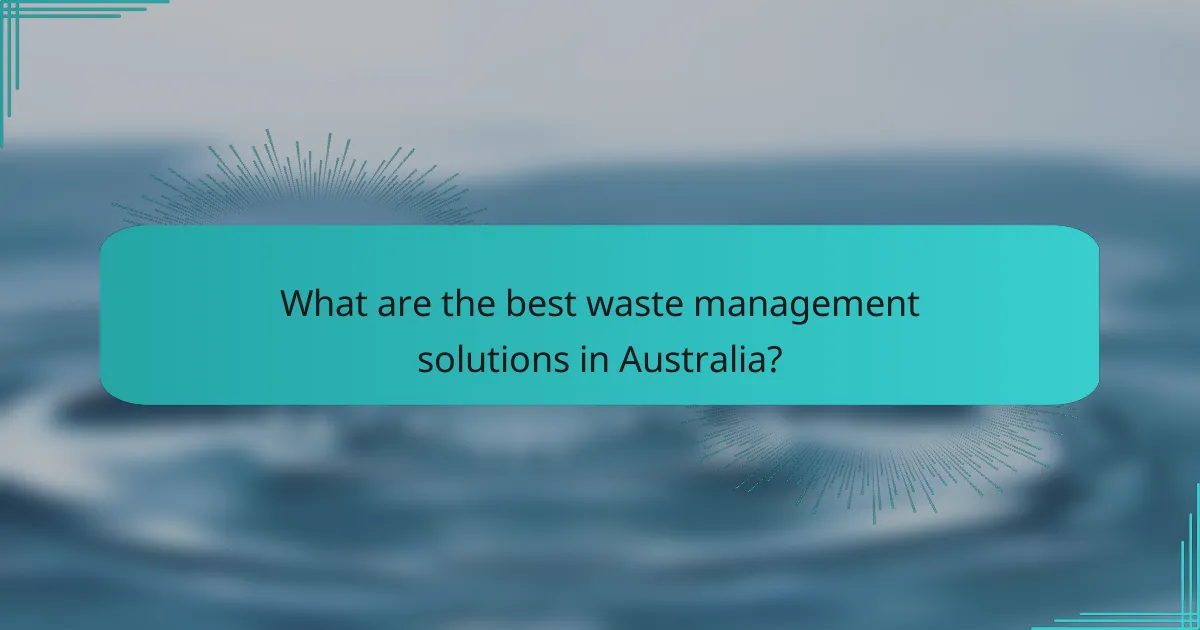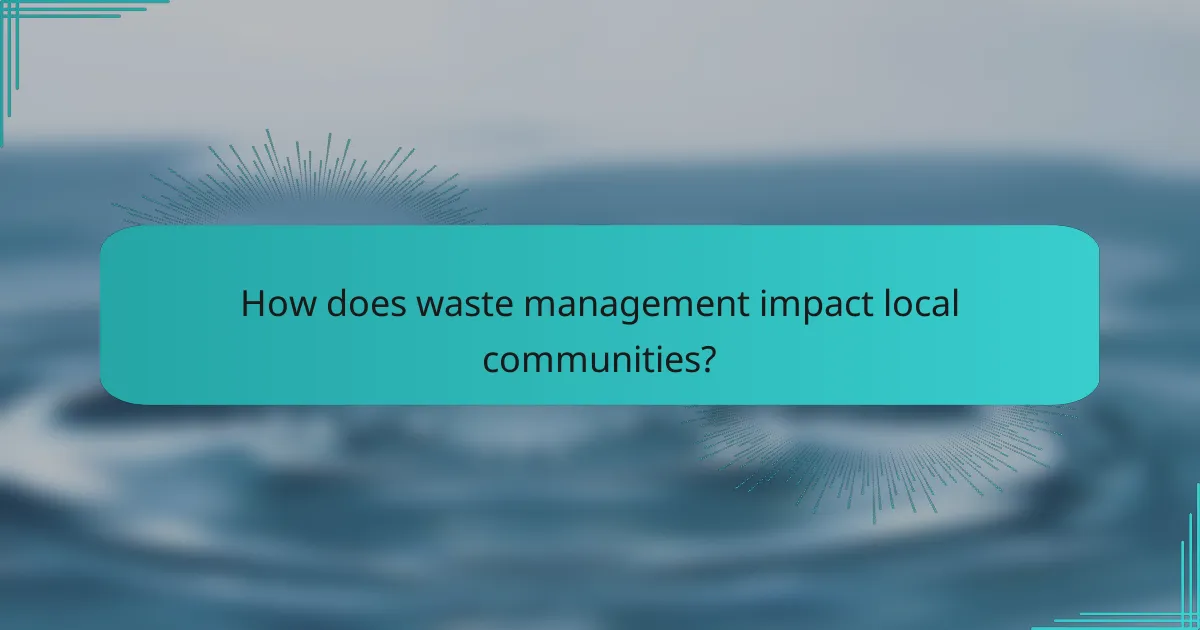Effective waste management solutions play a crucial role in promoting sustainability and enhancing community well-being. By implementing recycling options, composting services, and waste reduction strategies, we can significantly minimize waste and conserve natural resources. These initiatives not only reduce pollution and energy consumption but also foster a culture of responsibility within communities.

What are the best waste management solutions in Australia?
The best waste management solutions in Australia include composting services, recycling programs, waste-to-energy facilities, and landfill diversion strategies. These approaches aim to minimize waste, promote sustainability, and enhance community well-being.
Composting services
Composting services convert organic waste into nutrient-rich compost, which can be used to enrich soil. Many local councils in Australia offer green waste bins specifically for compostable materials, making it easy for residents to participate.
To effectively compost at home, consider using a compost bin or pile, ensuring a balance of green materials (like food scraps) and brown materials (like dried leaves). Regularly turning the compost will speed up the decomposition process.
Recycling programs
Recycling programs in Australia focus on collecting and processing materials like paper, glass, plastics, and metals to reduce landfill waste. Most municipalities provide curbside recycling bins, which residents can use to separate recyclables from general waste.
It’s important to follow local guidelines on what can be recycled, as contamination can lead to entire batches being sent to landfills. Common recyclable items include clean containers, cardboard, and certain plastics, while items like plastic bags and food waste should be avoided.
Waste-to-energy facilities
Waste-to-energy facilities convert non-recyclable waste into energy through processes like incineration or anaerobic digestion. This method not only reduces the volume of waste but also generates electricity or heat, contributing to the energy grid.
While waste-to-energy can be an effective solution, it is essential to ensure that emissions are controlled and that the facility complies with environmental regulations. Communities should weigh the benefits of energy generation against potential environmental impacts.
Landfill diversion strategies
Landfill diversion strategies aim to reduce the amount of waste sent to landfills by promoting recycling, composting, and other sustainable practices. These strategies often involve community education and incentives to encourage participation in waste reduction initiatives.
Examples of effective diversion strategies include implementing pay-as-you-throw programs, which charge residents based on the amount of waste they generate, and establishing community drop-off centers for recyclable and compostable materials. Engaging local businesses in sustainability efforts can further enhance these initiatives.

How can recycling options reduce waste?
Recycling options significantly reduce waste by converting materials that would otherwise end up in landfills into reusable resources. This process not only conserves natural resources but also minimizes pollution and energy consumption associated with producing new materials.
Material recovery facilities
Material recovery facilities (MRFs) are specialized plants that sort and process recyclable materials. They use a combination of manual labor and advanced technology, like conveyor belts and shredders, to separate items such as plastics, metals, and paper. By efficiently recovering these materials, MRFs play a crucial role in increasing recycling rates and reducing landfill waste.
Communities can benefit from MRFs by ensuring that a higher percentage of recyclable materials are diverted from landfills. However, it’s essential to educate residents on proper recycling practices to minimize contamination, which can hinder the efficiency of these facilities.
Single-stream recycling
Single-stream recycling allows residents to place all recyclables into one bin without sorting them. This convenience often leads to higher participation rates in recycling programs, as it simplifies the process for households. However, it can result in increased contamination rates, which may affect the quality of the recycled materials.
To maximize the benefits of single-stream recycling, communities should provide clear guidelines on what can and cannot be recycled. Regular educational campaigns can help reduce contamination and improve the overall effectiveness of the program.
Extended producer responsibility
Extended producer responsibility (EPR) is a policy approach that holds manufacturers accountable for the entire lifecycle of their products, including post-consumer waste. By requiring producers to manage the disposal and recycling of their products, EPR encourages the design of more sustainable goods and reduces waste in landfills.
Countries implementing EPR often see a decrease in waste generation and an increase in recycling rates. For instance, in the European Union, EPR regulations have led to significant improvements in recycling performance across various sectors. Businesses should stay informed about local EPR regulations to ensure compliance and contribute to waste reduction efforts.

What are the benefits of waste reduction strategies?
Waste reduction strategies offer significant advantages, including lower operational costs and a smaller environmental footprint. By minimizing waste, businesses and communities can improve efficiency, enhance sustainability, and foster a culture of responsibility.
Cost savings for businesses
Implementing waste reduction strategies can lead to substantial cost savings for businesses. By reducing waste, companies can lower disposal fees, decrease the need for raw materials, and optimize their supply chain. For instance, businesses that adopt recycling programs often see a reduction in waste management costs by up to 30%.
Additionally, investing in waste reduction technologies can yield long-term financial benefits. For example, energy-efficient machinery can decrease energy costs while simultaneously reducing waste generation. Companies should regularly assess their waste management practices to identify areas for potential savings.
Environmental impact reduction
Waste reduction strategies significantly decrease environmental impact by minimizing landfill use and lowering greenhouse gas emissions. By diverting waste from landfills through recycling and composting, communities can contribute to a healthier ecosystem. For instance, recycling one ton of paper can save approximately 17 trees and reduce carbon emissions.
Moreover, reducing waste conserves natural resources and energy. By choosing sustainable materials and practices, businesses can lessen their ecological footprint. Adopting a circular economy approach, where products are reused and recycled, can further enhance environmental benefits.
Community engagement
Waste reduction strategies foster community engagement by encouraging local participation in sustainability initiatives. When communities come together to implement recycling programs or clean-up events, they build a sense of ownership and responsibility towards their environment. This collective effort can lead to stronger community ties and increased awareness of environmental issues.
Moreover, educational campaigns about waste reduction can empower residents to adopt sustainable practices at home. Local governments can support these initiatives by providing resources and incentives, such as discounts for recycling or composting services. Engaging the community in waste reduction efforts not only benefits the environment but also enhances the quality of life for residents.

How does waste management impact local communities?
Waste management significantly influences local communities by promoting environmental sustainability, enhancing public health, and fostering economic growth. Effective waste management practices, such as recycling and waste reduction, can lead to cleaner neighborhoods and improved quality of life for residents.
Job creation in recycling sectors
The recycling industry is a major source of job creation within communities. Positions range from collection and sorting to processing and sales, often providing employment opportunities for individuals with varying skill levels. In many regions, recycling initiatives can create hundreds to thousands of jobs, contributing to local economies.
Investing in recycling facilities and programs can stimulate further economic growth. For instance, local governments that support recycling initiatives often see a return on investment through job creation and increased local spending.
Improved public health outcomes
Effective waste management leads to improved public health by reducing pollution and minimizing exposure to hazardous materials. Communities that actively recycle and reduce waste often experience lower rates of respiratory illnesses and other health issues linked to waste mismanagement.
Additionally, cleaner environments foster healthier lifestyles. Parks and public spaces that are well-maintained and free from litter encourage outdoor activities, which can lead to better physical and mental health for residents.
Community beautification projects
Community beautification projects often arise from successful waste management initiatives. These projects can include the installation of recycling bins, community gardens, and public art installations that enhance the visual appeal of neighborhoods. Such efforts not only improve aesthetics but also foster a sense of pride among residents.
Engaging community members in beautification projects can strengthen social ties and encourage collective responsibility for local environments. Programs that involve residents in clean-up days or planting initiatives can lead to sustained improvements in community appearance and cohesion.

What criteria should businesses consider when choosing waste management services?
Businesses should evaluate service reliability, cost-effectiveness, and environmental compliance when selecting waste management services. These criteria ensure that the chosen provider meets operational needs while adhering to budget constraints and regulatory standards.
Service reliability
Service reliability is crucial for maintaining consistent waste disposal and recycling operations. Businesses should assess the provider’s track record for meeting scheduled pickups and handling unexpected issues, such as equipment breakdowns or staffing shortages.
Consider asking for references or case studies from similar businesses to gauge reliability. A reliable service minimizes disruptions and helps maintain a clean and safe environment.
Cost-effectiveness
Cost-effectiveness involves evaluating the overall value of waste management services relative to their price. Businesses should compare quotes from multiple providers, taking into account not just the base fee but also any additional charges for extra pickups or recycling services.
Look for providers that offer transparent pricing structures and flexible service options. It may be beneficial to consider long-term contracts that could yield discounts, but ensure that the terms align with your business’s growth and waste generation patterns.
Environmental compliance
Environmental compliance ensures that waste management practices adhere to local regulations and sustainability standards. Businesses should verify that the provider follows all relevant laws regarding waste disposal and recycling, which can vary significantly by region.
Inquire about the provider’s recycling rates and methods, as well as their commitment to reducing landfill waste. Choosing a compliant service not only mitigates legal risks but also enhances the business’s reputation as an environmentally responsible entity.

What are the emerging trends in waste management solutions?
Emerging trends in waste management solutions focus on innovative technologies and sustainable practices that enhance recycling, reduce waste, and positively impact communities. These trends include the adoption of smart technologies and the promotion of circular economy initiatives, both aimed at improving efficiency and sustainability in waste handling.
Smart waste management technologies
Smart waste management technologies utilize IoT devices, sensors, and data analytics to optimize waste collection and processing. For instance, smart bins equipped with sensors can monitor fill levels and notify waste collectors when they need to be emptied, reducing unnecessary trips and fuel consumption.
Another example is the use of mobile apps that allow residents to report overflowing bins or schedule pickups, enhancing community engagement. Implementing these technologies can lead to significant cost savings and improved service delivery, particularly in urban areas.
Circular economy initiatives
Circular economy initiatives aim to minimize waste by promoting the reuse and recycling of materials. This approach encourages businesses and consumers to rethink their consumption habits, focusing on sustainable products that can be recycled or repurposed at the end of their life cycle.
Examples include programs that incentivize consumers to return used products for recycling or companies that design products with recyclable materials. Communities can support these initiatives by participating in local recycling programs and advocating for policies that promote sustainable practices.


